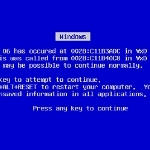Windows MVP John D. Carrona discusses the improved stability offered with Windows 8/8.1.
–PC Pitstop.
Fewer BSODs with Windows 8?
By Windows Talk
This content was provided by Windows MVP John D. Carrona whom I recently interview here. One of the questions I originally asked him was: Are there fewer BSODs (Blue Screen of Death) with Windows 8 compared to previous versions? It required a longer response, so John has kindly allowed me to publish this article.
Are there fewer BSODs with Windows 8?
A difficult question, as the BSOD’s ebb and flow as time goes on. In general, I find fewer BSOD’s in Win8/8.1 systems than I did in Win7 systems. But there’s some additional considerations here.
There’s the difference between a developer analyzing a BSOD in order to fix a driver that they’ve written and a user trying to fix a BSOD on their own system. When a developer analyzes a crash dump, they usually look at the individual instructions in order to see where the error occurred – whereas a user doesn’t need to look at the instructions (and even if they did, they would have no use for this information as they cannot rebuild the driver).
What can cause a BSOD?
BSOD’s are caused by problems with the operating system in the kernel space. They occur when the kernel or a driver running in kernel mode encounters an error from which it cannot recover. When this happens the system is designed to “fail fast” so that there isn’t any damage to the system. This may result in data loss as the system reboots before the user has a chance to save anything that is being worked on. According to the documentation, a user mode function cannot directly cause a BSOD – it must use accepted routines to perform actions in the kernel space – and the kernel space is where the errors occur that generate BSOD’s.
Shared with permission from Windows Talk.




